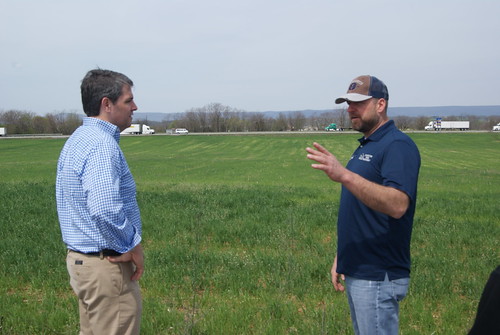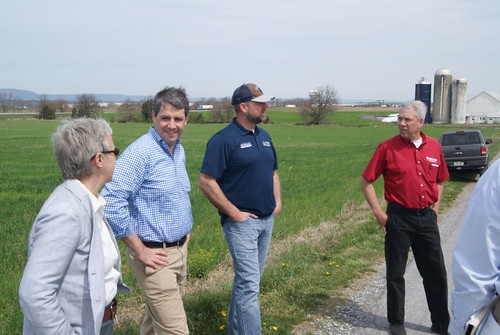
USDA Risk Management Agency Associate Administrator Tim Gannon (left) and Jason Forrester talk about planting plans on one of Forrester’s farms in Chambersburg, Pa.
I hit the road last week to get feedback from farmers in Pennsylvania on how recent Federal crop insurance enhancements are helping organic producers in the state.
Earlier this year, USDA expanded crop insurance options to allow organic producers to purchase coverage that better reflects their product’s actual value. The expanded coverage is part of our continued commitment to provide farmers with resources and tools to meet the growing demand for certified organic products.
The organic sector has experienced remarkable growth, representing more than $39 billion in U.S. retail sales. This growth creates opportunities for farmers and businesses across the country. Expanding the safety net for farmers wanting to enter the organic market ensures they have the tools and resources they need.
Hannah Smith-Brubaker, Deputy Secretary of Pennsylvania’s Department of Agriculture, joined me during my visits to two farms in Chambersburg, Pennsylvania.
We met with Jason and Tony Forrester, cousins who have multiple farms in the Chambersburg area. Both have Federal crop insurance policies that cover certified organic crops including corn, soybeans and wheat.
Jason Forrester, who has nearly 900 acres, all certified organic or in transition, told me he “never bats an eye” at paying his policy premium. “If not me, I know some farmer, somewhere, is going to need it,” he said.
Last year, USDA reported that U.S. certified and exempt organic farms sold a total of $5.5 billion in organic products in 2014, up 72 percent since 2008. There were more than 6,000 organic crop insurance policies in effect in 2014.
Jason said that farmers don’t even have to advertise their organics products because the buyers “come to you.” And many of those buyers are local. He sells some products to a local creamery operation right down the street from one of his farms.
Among the changes discussed for 2016 was the Contract Price Addendum, which allows producers transitioning to certified organic to cover their production of 73 eligible crops at a higher price than traditional crops.
Also in 2016, RMA continued to add to the number of crops eligible for an organic premium price election. That’s now up to 57 commodities for the 2017 crop year.
We received a lot of good feedback during our visit. RMA is constantly seeking input from producers on how we can improve crop insurance products, which have become such a huge part of the safety net available to American ranchers and farmers.
USDA has also established a number of resources to help organics producers find technical and financial resources to help them grow domestically and abroad. You can visit www.usda.gov/organicto learn more about USDA’s support to the organic industry. More information on risk management tools available for agricultural producers is available at the RMA website. That includes a fact sheet on the Contract Price Addendum and other information specifically geared toward organic and transitioning farmers.

(From left) Pennsylvania Department of Agriculture Deputy Secretary Hannah Smith-Brubaker, USDA Risk Management Agency Associate Administrator Tim Gannon, Jason Forrester and Tony Forrester talk about crop insurance for organic farmers at one of their farms in Chambersburg, Pa.
No comments:
Post a Comment
Note: Only a member of this blog may post a comment.